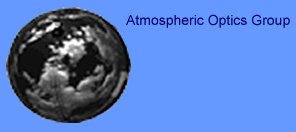
 |
| |
|
|
|
|
|
|
|
Atmospheric Beam Transmittance DistributionSeveral years ago, we had the idea that it should be possible to determine the earth-to-space beam transmittance at many points over the sky by using the images of the night sky, such as that shown below. Night Sky with Thin Clouds Although funding constraints precluded our investigating this at the time, we are now proceeding with this project. Evaluation of the radiance field near stars indicated that in the presence of clouds, the magnitude of the peak is decreased (as expected), the background level may increase, and the spatial texture of the background is changed.
After studying the behavior of the night sky images, we derived techniques for determining the earth-to-space beam transmittance from the night images. The first step involves using star libraries to determine the anticipated signal from the stars. Using libraries of stellar magnitude, and libraries of color temperature, we have derived a library of inherent star irradiance for the WSI passbands. The figure below shows a plot of the derived inherent irradiance as a function of the stellar magnitude.
While this work is in development, we feel this technique has tremendous
potential, not only for determining the real-time spatial distribution
of beam transmittance, but also for evaluating the star libraries themselves,
since we can make determinations for many hundreds of stars simultaneously
and check the calibrations on the basis of the well-known stars.
Produced
by the Marine Physical Laboratory, SIO.
|